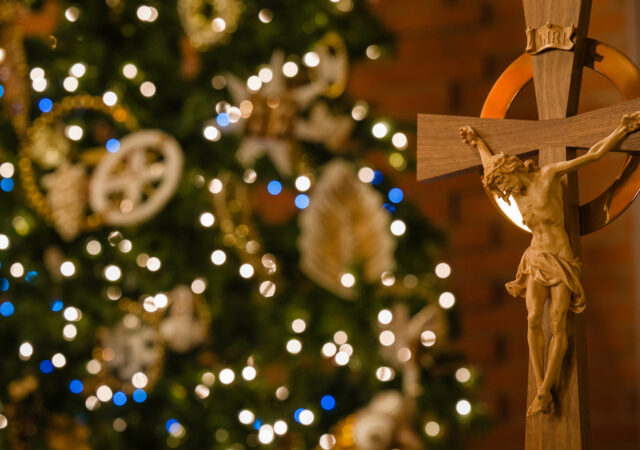By Paula Schlueter Ross (paula.ross@lcms.org)
ST. LOUIS — It wasn’t expected, but it wasn’t really too surprising, either, when LCMS Disaster Response Manager Rev. Michael Meyer left midway through the four-day National Disaster Response Conference here to attend to a disaster: the recent flooding in South Carolina.

After all, disasters can happen at any time, as Meyer and his colleague, LCMS Disaster Response Director Rev. Ross Johnson, know all too well.
But the timing of those two events provided “a great opportunity” for conference-goers “to see the need, and work together to fill it,” Johnson told Reporter. And, as a result, some 700 “flood buckets” of cleanup supplies provided by disaster-response coordinators from the LCMS Florida-Georgia District were delivered to South Carolina within days.
This year’s conference, “Deliver Us from Evil: God at Work in Disaster,” Oct. 6-9 at Concordia Seminary, brought together nearly 100 district disaster-response coordinators, pastors and laypeople involved in disaster work, and a few others interested in learning how to respond in the wake of disasters.
The event is designed to increase awareness of disaster response — what it entails and how Lutherans can get involved — as well as training, and sessions covered topics such as “How Worship Can Be Healing in Times of Suffering,” “Disaster Response Chaplains,” “Post-Traumatic Stress Disorder,” “Flood Buckets, Trailers and Chainsaw Teams,” “Luther and Mercy,” “Theology of the Cross,” “Psalms in Times of Tragedy” and “LERT [Lutheran Early Response Team] Update and Disaster Grants.”
Pilger tornadoes
In the first of four “case studies” presented by LCMS pastors who ministered to their congregations and communities following tornadoes and a flood, the Rev. Terry Makelin, pastor of St. John Lutheran Church in Pilger, Neb., described his tornado-damaged church and home and the “phenomenal” outpouring of financial gifts that enabled the congregation to distribute $250,000 in aid to some 60 local families.
Twin tornadoes pummeled the tiny farming community of Pilger on June 16, 2014, killing two, injuring 20 and wiping out most of its homes and businesses (see related story).
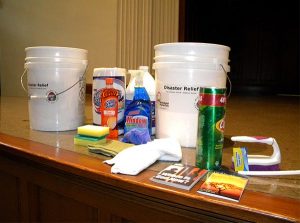
All that remained of St. John was a concrete slab and bricked bell tower. Two closets were the only things standing in Makelin’s house, and the tornadoes dropped a car into a hallway. The homes of 18 St. John families were either destroyed or heavily damaged.
The first three weeks after a disaster like that, said Makelin, who wasn’t at home during the storm, are typically spent picking up debris. Then you start fixing things.
Seeing the needs
What’s the best way to help? By doing “anything,” he said, and he encouraged congregation members to stand with their pastor after a disaster so he can quickly hand tasks off to them.
And to pastors, Makelin advised: “Be out there” in the neighborhoods, in the community, because “people are hungry for the Word of God” after a disaster. “Wear your clerical [shirt] and deliver that Word of God.”
Makelin said he’s convinced there are two reasons the walls of his church came down in the storm: so that the congregation could “see the people in need” in the community and would realize that God is with us, even in times of suffering.
One of those killed in the Pilger tornadoes was a young girl, 5, and Makelin — who lost a 5-year-old son in a drowning accident in 1988 — found himself consoling the girl’s grieving mother.
“How would I have known that the loss of my son 25 years ago would enable me to minister to this woman who lost her 5-year-old daughter?” he said.
How do you console hurting people? “The answer is Jesus Christ crucified,” he said. “It always is.” And knowing that God is there, “working in us and through us.”
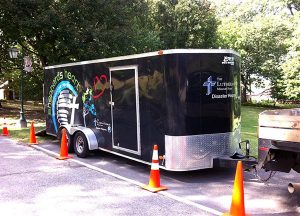
Makelin added that now, a year later, he’s living in a new home and St. John just broke ground for a new building, to be completed by June 2016.
Also presenting case studies at the conference were the Rev. Thomas Heren, pastor of Our Savior Lutheran Church, Washington, Ill.; the Rev. Brian Bucklew, pastor of Zion Lutheran Church, Delmont, S.D.; and the Rev. Seth Clemmer, associate pastor of Bethany Lutheran Church, Naperville, Ill.
Resources for response
In his presentation on “The LCMS and Disaster Response,” Johnson said the Synod ministry works through congregations, adding that disasters “provide great opportunities to proclaim the Gospel” and “meet physical and spiritual needs.”
“You are not alone” when responding to disasters, he said, and he listed available resources including Synod districts and district presidents, district disaster-response coordinators, LCMS Disaster Response, LERT volunteers and the LERT training manual and a variety of print materials (some in Spanish) available from the lcms.org/disaster website. New are a five-part Bible-study series and “Mercy in Action: Essays on Human Care, Mercy and Disaster Response.”
Johnson said a response includes four phases — making assessments, developing an action plan, having the resources to respond and implementing the action plan — and listed some goals of LCMS Disaster Response, such as helping each Synod district become a “self-contained responder” with at least one supply trailer and trained volunteers. On display during the conference was the 20-foot trailer used by the LCMS Southern District’s Shepherd’s Heart Disaster Response Ministry.
Grants are available to help with disaster-response preparedness, Johnson said, and he encouraged those interested to send an email to disaster@lcms.org.
‘Part of our DNA’
Mission, doctrine and mercy were all part of the early Church, noted LCMS President Rev. Dr. Matthew C. Harrison in his presentation on mercy, and he read excerpts supporting that view from the writings of “two giants” in LCMS history — Wilhelm Löhe and C.F.W. Walther — as well as the New Testament’s book of Acts.
Harrison, who led LCMS World Relief and Human Care before his election as Synod president, said that caring for people in need, particularly in disasters, “is not something that is foreign” to Christians, but “is absolutely part of our DNA that flows from the Gospel,” and congregations have a “duty” to care for all “in body and soul.”
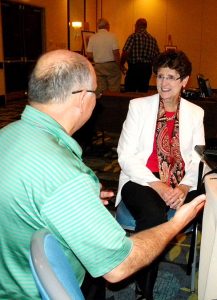
‘Child-size Trauma’
In her presentation at the conference banquet on “Responding to Child-size Trauma,” Dr. Beverly Yahnke, executive director for Christian Counsel with DOXOLOGY: The Lutheran Center for Spiritual Care and Counsel, said children and the elderly are often overlooked in disaster response.
Children’s coping abilities — and their psychological and spiritual health — are important for predicting how they will respond to trauma from a disaster, said Yahnke, and she listed the various signs of trauma among children at different ages, including sleep disorders, headaches, depression and risky behavior.
An “amazing resource,” she said, is the National Child Traumatic Stress Network at nctsn.org, which offers information and resources for parents.
When assisting a child during a disaster, Yahnke advised addressing safety concerns first: make sure they’re safe; offer water, food and a blanket, if needed; and provide them with accurate information. Remember to “stay calm,” she said, because what you say can be “life-changing for them,” and don’t promise what you can’t deliver, such as saying, “You’ll feel better soon.”
The most important thing you can do for a child during a disaster? Stay with him or her. Tell the child you’re there to help, and point out the other helpers, such as police officers and firemen.
“Comfort dogs are wonderful” in a disaster, Yahnke said, and petting the dogs helps kids “focus on the moment” rather than the trauma they experienced.
Yahnke talked about various therapies for traumatized children, such as talking, playing and drawing, and suggested the book A Terrible Thing Happened, by Margaret M. Holmes, as a good resource. Spiritual care also is important, she said, and praying, singing hymns and taking part in worship services are often comforting to children, who are reassured that “God is in control” and “God cares.”
Comfort dogs in Roseburg
In a presentation on K-9 Comfort Dogs, a ministry of Lutheran Church Charities, Northbrook, Ill., the Rev. Ron Norris, district disaster-response coordinator for the LCMS Northwest District and an emergency-services chaplain, said six teams of comfort dogs and handlers visited Roseburg, Ore., after the Oct. 1 shooting at Umpqua Community College (UCC) there, meeting with students, first responders and dispatchers at a 911 call center. In a post-conference update, Norris said another group of eight teams returned to Roseburg for a second week beginning the day before UCC classes resumed on Oct. 12 and spent up to 15 hours on campus each day. Everyone — students, faculty and residents alike — appreciated the dogs being there, he said.
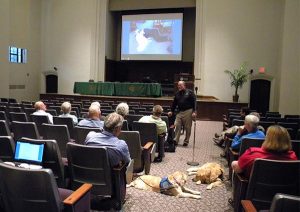
In such disaster situations, he said, “the people will pet the dogs, and they will talk and they will cry — and we will hug them and pray.” The dogs, he said, “are the ones who allow us to talk about Jesus.”
For more information on comfort dogs, send an email to info@k9comfort.org.
Understanding ‘mercy’
The Rev. Ron Simpson, disaster-response coordinator for the LCMS Oklahoma District and pastor of Good Shepherd Lutheran Church and School in Midwest City, Okla., was part of an eight-person delegation from three Oklahoma congregations that attended the conference to “gain greater insight regarding disaster-response possibilities.”
Simpson told Reporter he believes it’s “important to invest in the service of our volunteers.” Attending the conference, he said, “allows them to grow and understand mercy and doing the Gospel beyond social work, allows them to see the national scope of the Synod’s work, allows them to interact with [Synod] officials and rewards them with some downtime in enjoying the venue.”
The sessions were valuable, he said, in keeping “our message and witness straight” theologically, “as we minister to a hurting community,” and “practical insights on the ‘how-tos’ of disaster response has helped keep us from reinventing the wheel on so many operational matters.”
The “training and education” provided at the annual conferences “helps fill the gap when the what-do-I-do-now and how-do-I-do-it moments strike,” Simpson said.
Perhaps most important, he added, is giving “a correct explanation for the mercy we share with those in need in the wake of a disaster: because we have received mercy.”
Posted Oct. 23, 2015



